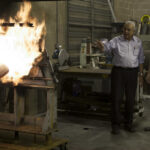Why Does Reverse Gears Whine? (and How to Fix it)
Why Does Reverse Gear Whine?
Reverse gear whines for a few reasons: the fluid line might be clogged, or there can be an issue in the converter.
When you’re operating your vehicle, you will notice a whining sound coming from your transmission. When a whining noise comes from your transmission, there is a spread of potential causes, making it difficult to pin down the problems without help from dealership maintenance professionals.
However, there are some things that you just can check after noticing a whining noise.
If the whining noise coming from your transmission gets worse when your vehicle is in reverse, this usually means the transmission fluid line is clogged. A clogged conductor is usually symptomatic way more severe transmission issue, which suggests you ought to take your vehicle to the service and business department at your dealership as soon as possible.
Should the whining noise of your transmission continue whenever your vehicle is geared, this could mean, there’s an issue occurring in your converter. Check to determine if the noise desists after you shift the vehicle to park or neutral. A relentless whining noise when your car is geared needs professional attention.
Also read: Manual or Automatic- which Transmission Last Longer?
Reverse Gear Whining: Step-by-Step
Step 1: Ruling out engine noise. If the car doesn’t make the noise when it’s not geared, the likelihood is that it isn’t an engine noise.
Race the engine gently with the car in Neutral and listen carefully for any signs of the offensive noise that are related to the engine speed. A noise that happens when the car is shifted into gear is presumably related to the transmission with some exceptions.
Step 2: Manual or automatic. If your car contains a manual transmission, the sounds that it makes can mean entirely various things from an automatic.
Does the sound occur once you put your foot on the clutch to shift into gear? Then you almost certainly staring at a release bearing, which suggests clutch replacement. Does the sound occur because the car just starts to maneuver as you release the clutch then flee when the car is in motion? that will be a pilot bearing, which also means clutch replacement.
A manual transmission is merely turning when the car is either in motion or when the transmission is in neutral and, therefore, the clutch is engaged (your foot is off the pedal). It so sounds that occur while the car is stationary and geared are possibly related to the clutch. Whirring sounds that occur while the car is in motion may indicate transmission bearing noises or driveline noises.
Step 3: Check the fluid. If your car contains a manual transmission, checking the fluid will be a giant job. The car has got to be jacked up, and a check plug far away from the side of the transmission.
A transmission system can be easier, but manufacturers have begun to eliminate dipsticks and fill spouts from the user-serviceable hardware in recent years. Check your workshop manual for instructions on checking the automated transmission fluid.
Either way, it’s a vital step. Low fluid can cause all types of problems, and noises are usually the primary noticeable symptoms. Catching a coffee fluid level early can prevent lots of cash.
If the noise began shortly after you had the transmission serviced, contact the service professional to determine exactly what fluid was used. Within the last 15 years, many transmission manufacturers have been using their own special fluid, and using anything can sometimes cause inappropriate noises.
Step 4: Put the car in Reverse. If your car has an automatic drive, there are some other checks you’ll make.
With the engine running, put your foot on the brake and put the car in Reverse. Does the noise get worse? If this is often the case, you would possibly have a restricted transmission filter.
When the car is is in reverse, the transmission pressure rises, and also the transmission demand for fluid rises with it. A restricted filter won’t allow the fluid to pass quickly enough. You’ll be able to change the fluid and filter if this is often the case or have it in serious trouble you, but it’d not be the tip of your troubles. If the filter is clogged, it’s clogged with debris from the within of the transmission, so something else is breaking down.
Also read: 15 Cars that NEVER Rust (100% Galvanised)
Step 5: Check the convertor. The converter is what your transmission system has rather than a clutch. The converter is spinning anytime the engine is running but is barely under load when the car is geared either forward or reverse. As soon as you shift into Neutral, the sound goes away.
The convertor is found where the engine meets the transmission. Put your mechanic’s stethoscope in your ears, but pull the probe off of the hose. this can provide you with a really directional tool for seeking out sounds.
While a lover keeps the car geared with their foot firmly on the brake, wave the tip of the hose around the transmission and check out to pinpoint the direction the noise is coming from. A converter will generate noise from the front of the transmission.
Trending Video: How to Easily Bring Back to Life any Old Car Battery and Save Tons of Money (click to watch)
Step 6: Drive the car. If the noise doesn’t occur unless the car is in motion, you’ll have trouble with one or more gears or bearings within the transmission. There are many parts within the transmission that are stationary unless the car is underway. Planet gear sets can produce whining noises because the gears begin to wear out, but they’re going only to complain when the car is moving.
Determining and correcting the precise explanation for transmission noise could also be beyond the scope of the amateur mechanic. If the matter can’t be solved by topping off the oil or changing the filter, there’s probably little which will be done that doesn’t involve transmission removal. Having it checked by knowledgeable reception by a technician, like one from YourMechanic, can go far towards easing your worry.
Does Reverse Gear Whine in Every Car?
Reverse gear doesn’t whine in most transmissions. That’s because the forward gears are what’s referred to as helical gears, which have angled teeth and are in constant mesh with each other. The angles of the teeth keep the teeth in constant contact with each other, which makes the gears quiet.
For reverse gear, most transmissions use spur gears, also called straight-cut gears. These are used because they’re less expensive to provide than helical gears, and since a reverse gear actually uses three gears to reverse the direction of the input shaft, that adds up.
Can You Do Something to Cut Back Whining?
Many whining problems are often solved by tightening or replacing belts, which you’ll be able to do yourself, or by replacing fluid.
In fact, the primary thing you ought to do anytime your car is making strange noises is to test all of your fluid levels






